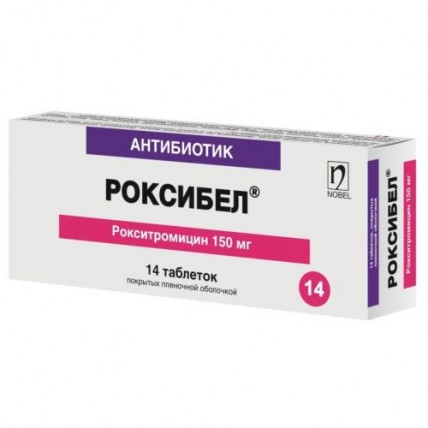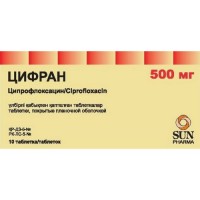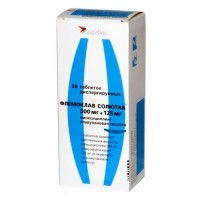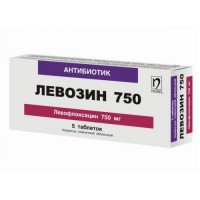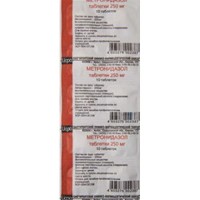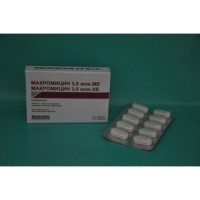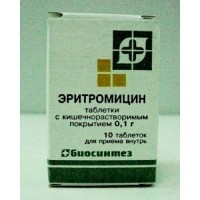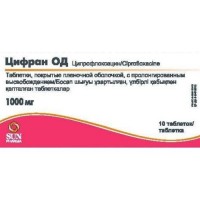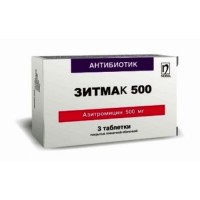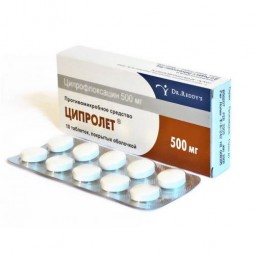Roksibel 14s 150 mg coated tablets
- $17.40
The instruction for use
of medicine for experts
of Roksibel®
the Trade name
of Roksibel®
the International unlicensed
name Roksitromitsin Lekarstvennaya
the Tablet form, film coated 150 mg
Structure
One tablet contains
active agent – roksitromitsin 150.00 mg,
excipients: oksitilen oksipropilenpolimer, PVP K 30,
hydroxypropyl cellulose, aerosil 200,
corn starch, magnesium stearate, talc,
opadr pink (OYS 24948).
The description
Round tablets, with a biconvex surface, film coated pink color, on a break of white color
Pharmacotherapeutic group
Antimicrobial drugs for systemic action. Macroleads
Code of automatic telephone exchange J01FA06.
The pharmacological
Pharmacokinetics Roksitromitsin properties it is quickly soaked up from digestive tract. Is defined in serum in 15 minutes. Meal does not influence absorption. The maximum concentration in blood plasma is reached in 1.5 - 2 hours. Roksitromitsin well gets into fabrics, especially into lungs, tonsils, a prostate and also in neutrophils and monocytes, stimulating their phagocytal activity. Linking with proteins of plasma makes 96%. With breast milk less than 0.05% of the accepted dose are allocated.
It is partially metabolized in a liver, the most part is removed with a stake in not changed look, about 12% are removed by kidneys and about 15% are removed by lungs. Elimination half-life at normal function of kidneys makes 10.5 hours.
A pharmacodynamics
Roksitromitsin – a semi-synthetic antibiotic of group of macroleads. The mechanism of action is caused by disturbance of intracellular synthesis of protein of microorganisms. It is active concerning gram-positive bacteria: Streptococcus pneumoniae, Streptococcus pyogenes, Methicillinum - sensitive strains of Staphylococcus aureus, concerning gram-negative bacteria: Moraxella catarrhalis, and is also active concerning Mycoplasma pneumoniae, Ureaplasma urealyticum, Chlamidia spp, Haemophilus influenzae, Bordetella pertussis, Branchamella catarrhalis, Gardnerella vaginalis.
Maloaktiven concerning Mycoplasma hominis. Pseudomonas spp., Enterobacter spp., Acinetobacter spp are resistant to a roksitromitsin.
Indications
- infections of upper and lower airways (sinusitis, tonsillitis, pharyngitises, average otitis, an acute bronchitis, exacerbation of chronic bronchitis, community-acquired pneumonia)
- infections of skin and soft tissues
- negonokokovy infections of an urinogenital system (not gonococcal uretrita, prostatitises, uncomplicated chlamydial infections)
the Route of administration and doses
to Adults, children and teenagers are more senior than 12 years with body weight higher than 40 kg drug appoint orally in a dose of 150 mg two times a day or 300 mg once a day before food (in 15 minutes) or on an empty stomach. Correction of a dose is not required to elderly patients and also patients with a moderate renal failure, however with a heavy renal and liver failure it is recommended to patients to accept no more than 150 mg a day.
Maximum single dose of 300 mg, daily 300 mg.
For children aged up to 12 years with body weight not less than 30 kg the daily dose makes 5-10 mg/kg of body weight, divided into two receptions.
Duration of reception is defined by indications, weight of infectious process and activity of the activator. The average duration of a course of treatment is 7-14 days.
Side effects
- nausea, vomiting, diarrhea, an abdominal pain, a meteorism, anorexia, tranzitorny
increase in level of hepatic transaminases, alkaline phosphatase in blood
(is more often at elderly patients)
Seldom:
- dizziness, a headache, paresthesias, a general malaise
- disturbance of taste and sense of smell
- an abnormal liver function, cholestatic hepatitis, pancreatitis
- skin rash, a small tortoiseshell, an itching, a Quincke's disease, a bronchospasm,
anaphylactoid reactions, a multiformny erythema, exfoliative
dermatitis, Stephens-Johnson's syndrome, the general hypostases
-
Contraindication candidiasis
- hypersensitivity to a roksitromitsin and other macroleads (including
erythromycin)
- heavy abnormal liver functions
- simultaneous use of alkaloids of an ergot with vasoconstrictive
effect
Medicinal interactions
At simultaneous use with indirect anticoagulants is possible strengthening of anticoagulating action.
At combined use with ergot drugs, ergotamine and dihydroergotamine the development of an ergotism (is possible up to necrosis of tissues of extremities).
At simultaneous use of a roksitromitsin and theophylline the increase in concentration of the last in blood plasma is possible (control of concentration of theophylline is necessary).
At simultaneous use with Disopyramidum, increase in concentration of the last as roksitromitsin can force out Disopyramidum from communication with proteins is possible.
Roksitromitsin can increase digoxin absorption, increases duration of effect of midazolam.
At simultaneous use with cyclosporine, increase in its concentration in blood plasma is possible.
At simultaneous use with Ethambutolum synergism concerning Mycobacterium avium is noted.
With care it is necessary to apply along with terfinadiny and astemizoly.
Special instructions
With care should be applied at patients with an abnormal liver function and kidneys.
At development of superinfection, pseudomembranous colitis drug it is necessary to cancel and appoint the corresponding therapy.
Pregnancy and a lactation
of Adequate and strictly controlled researches on safety of use of a roksitromitsin at pregnancy and in the period of a lactation it is not carried out. In need of use of drug at pregnancy it is necessary to estimate expected advantage for mother and potential risk for a fruit.
Roksitromitsin in small amounts is allocated with breast milk. In case of need prescribing of drug in the period of a lactation it is asked about the breastfeeding termination.
Features of influence of medicine on ability to run the vehicle or potentially dangerous mechanisms
Drug does not affect ability to run the vehicle and work with potentially dangerous mechanisms.
Overdose
Symptoms: headache, dizziness, nausea, vomiting, diarrhea,
abdominal pain
Treatment: gastric lavage and performing symptomatic treatment.
The form of release and packing
of the Tablet on 150 mg No. 10, No. 14 in the blister packing in a cardboard pack together with the instruction for use
to Store Storage conditions at a temperature from +15 °C to +30 °C in the dry, protected from light place.
To store out of children's reach!
2 years
not to apply an expiration date after an expiration date.
Prescription status
According to the prescription
JSC Nobel Almatinskaya Pharmatsevticheskaya Fabrika Producer
Republic of Kazakhstan, Almaty, Shevchenko St. 162 E.
of medicine for experts
of Roksibel®
the Trade name
of Roksibel®
the International unlicensed
name Roksitromitsin Lekarstvennaya
the Tablet form, film coated 150 mg
Structure
One tablet contains
active agent – roksitromitsin 150.00 mg,
excipients: oksitilen oksipropilenpolimer, PVP K 30,
hydroxypropyl cellulose, aerosil 200,
corn starch, magnesium stearate, talc,
opadr pink (OYS 24948).
The description
Round tablets, with a biconvex surface, film coated pink color, on a break of white color
Pharmacotherapeutic group
Antimicrobial drugs for systemic action. Macroleads
Code of automatic telephone exchange J01FA06.
The pharmacological
Pharmacokinetics Roksitromitsin properties it is quickly soaked up from digestive tract. Is defined in serum in 15 minutes. Meal does not influence absorption. The maximum concentration in blood plasma is reached in 1.5 - 2 hours. Roksitromitsin well gets into fabrics, especially into lungs, tonsils, a prostate and also in neutrophils and monocytes, stimulating their phagocytal activity. Linking with proteins of plasma makes 96%. With breast milk less than 0.05% of the accepted dose are allocated.
It is partially metabolized in a liver, the most part is removed with a stake in not changed look, about 12% are removed by kidneys and about 15% are removed by lungs. Elimination half-life at normal function of kidneys makes 10.5 hours.
A pharmacodynamics
Roksitromitsin – a semi-synthetic antibiotic of group of macroleads. The mechanism of action is caused by disturbance of intracellular synthesis of protein of microorganisms. It is active concerning gram-positive bacteria: Streptococcus pneumoniae, Streptococcus pyogenes, Methicillinum - sensitive strains of Staphylococcus aureus, concerning gram-negative bacteria: Moraxella catarrhalis, and is also active concerning Mycoplasma pneumoniae, Ureaplasma urealyticum, Chlamidia spp, Haemophilus influenzae, Bordetella pertussis, Branchamella catarrhalis, Gardnerella vaginalis.
Maloaktiven concerning Mycoplasma hominis. Pseudomonas spp., Enterobacter spp., Acinetobacter spp are resistant to a roksitromitsin.
Indications
- infections of upper and lower airways (sinusitis, tonsillitis, pharyngitises, average otitis, an acute bronchitis, exacerbation of chronic bronchitis, community-acquired pneumonia)
- infections of skin and soft tissues
- negonokokovy infections of an urinogenital system (not gonococcal uretrita, prostatitises, uncomplicated chlamydial infections)
the Route of administration and doses
to Adults, children and teenagers are more senior than 12 years with body weight higher than 40 kg drug appoint orally in a dose of 150 mg two times a day or 300 mg once a day before food (in 15 minutes) or on an empty stomach. Correction of a dose is not required to elderly patients and also patients with a moderate renal failure, however with a heavy renal and liver failure it is recommended to patients to accept no more than 150 mg a day.
Maximum single dose of 300 mg, daily 300 mg.
For children aged up to 12 years with body weight not less than 30 kg the daily dose makes 5-10 mg/kg of body weight, divided into two receptions.
Duration of reception is defined by indications, weight of infectious process and activity of the activator. The average duration of a course of treatment is 7-14 days.
Side effects
- nausea, vomiting, diarrhea, an abdominal pain, a meteorism, anorexia, tranzitorny
increase in level of hepatic transaminases, alkaline phosphatase in blood
(is more often at elderly patients)
Seldom:
- dizziness, a headache, paresthesias, a general malaise
- disturbance of taste and sense of smell
- an abnormal liver function, cholestatic hepatitis, pancreatitis
- skin rash, a small tortoiseshell, an itching, a Quincke's disease, a bronchospasm,
anaphylactoid reactions, a multiformny erythema, exfoliative
dermatitis, Stephens-Johnson's syndrome, the general hypostases
-
Contraindication candidiasis
- hypersensitivity to a roksitromitsin and other macroleads (including
erythromycin)
- heavy abnormal liver functions
- simultaneous use of alkaloids of an ergot with vasoconstrictive
effect
Medicinal interactions
At simultaneous use with indirect anticoagulants is possible strengthening of anticoagulating action.
At combined use with ergot drugs, ergotamine and dihydroergotamine the development of an ergotism (is possible up to necrosis of tissues of extremities).
At simultaneous use of a roksitromitsin and theophylline the increase in concentration of the last in blood plasma is possible (control of concentration of theophylline is necessary).
At simultaneous use with Disopyramidum, increase in concentration of the last as roksitromitsin can force out Disopyramidum from communication with proteins is possible.
Roksitromitsin can increase digoxin absorption, increases duration of effect of midazolam.
At simultaneous use with cyclosporine, increase in its concentration in blood plasma is possible.
At simultaneous use with Ethambutolum synergism concerning Mycobacterium avium is noted.
With care it is necessary to apply along with terfinadiny and astemizoly.
Special instructions
With care should be applied at patients with an abnormal liver function and kidneys.
At development of superinfection, pseudomembranous colitis drug it is necessary to cancel and appoint the corresponding therapy.
Pregnancy and a lactation
of Adequate and strictly controlled researches on safety of use of a roksitromitsin at pregnancy and in the period of a lactation it is not carried out. In need of use of drug at pregnancy it is necessary to estimate expected advantage for mother and potential risk for a fruit.
Roksitromitsin in small amounts is allocated with breast milk. In case of need prescribing of drug in the period of a lactation it is asked about the breastfeeding termination.
Features of influence of medicine on ability to run the vehicle or potentially dangerous mechanisms
Drug does not affect ability to run the vehicle and work with potentially dangerous mechanisms.
Overdose
Symptoms: headache, dizziness, nausea, vomiting, diarrhea,
abdominal pain
Treatment: gastric lavage and performing symptomatic treatment.
The form of release and packing
of the Tablet on 150 mg No. 10, No. 14 in the blister packing in a cardboard pack together with the instruction for use
to Store Storage conditions at a temperature from +15 °C to +30 °C in the dry, protected from light place.
To store out of children's reach!
2 years
not to apply an expiration date after an expiration date.
Prescription status
According to the prescription
JSC Nobel Almatinskaya Pharmatsevticheskaya Fabrika Producer
Republic of Kazakhstan, Almaty, Shevchenko St. 162 E.
